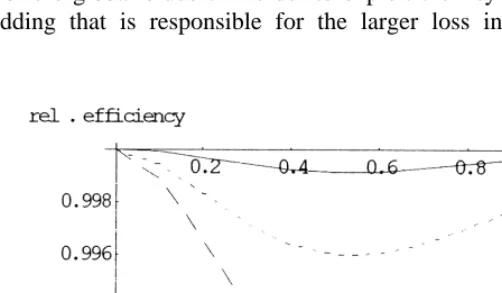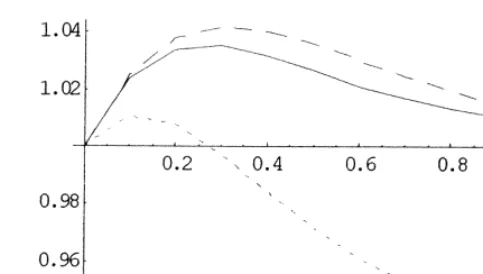www.elsevier.com / locate / econbase
A comparison of standard multi-unit auctions with synergies
a b ,
*
cGian Luigi Albano , Fabrizio Germano
, Stefano Lovo
a
Department of Economics, University College London, WC1E 6BT London, UK b
Eitan Berglas School of Economics, Tel Aviv University, 69978 Tel Aviv, Israel c
HEC, Finance and Economics Department, 78351 Jouy-en-Josas, France Received 12 October 1999; accepted 15 July 2000
Abstract
In an example where some bidders have superadditive values, we characterize the equilibria of a simultaneous ascending auction and compare the revenue and efficiency generated with ones generated by the sequential, the one-shot simultaneous, and the Vickrey–Clarke–Groves auctions. 2001 Elsevier Science B.V. All rights reserved.
Keywords: Ascending auctions; Multi-unit auctions; Complementarities
JEL classification: C72; D44
1. Introduction
The simultaneous ascending auction was first used in 1994 by the Federal Communication Commission to sell licences to use the spectrum in the United States (see e.g. McAfee and McMillan, 1996 and Cramton, 1997) for a description and evaluation of the actual FCC auctions). The auction was designed to address two main concerns. First, the ascending bids would provide an extensive process of information revelation that would enhance an efficient distribution of the licences. Second, the simultaneous sale of large sets of related licences would allow bidders to exploit possible complementarities between licences.
In this paper, we study a close variant of the simultaneous ascending auction within the framework of Krishna and Rosenthal (1996) and therefore emphasize the presence of complementarities in at least some of the bidders’ preferences. Within a simple example with two objects and four bidders (two local and two global bidders), we characterize the equilibria of the variant of the ascending
*Corresponding author. Tel.: 1972-3-640-9715; fax:1972-3-640-9908.
E-mail address: [email protected] (F. Germano).
auction and compare the outcome in terms of revenue and efficiency with other standard auctions studied in the literature, such as the sequential, the one-shot simultaneous, and the Vickrey–Clarke– Groves auctions. Our main object is to reinforce basic intuition for the relative performance of the mentioned auctions as compared to the present version of the simultaneous ascending auction; see also Branco (1997b) for related evidence.
2. A simultaneous ascending auction
2.1. Framework
We use a special case of the framework of Krishna and Rosenthal (1996). Two objects are put for sale to a set of four participants of two types: local bidders who are interested in one of the two objects and global bidders who are interested in both objects. For each of the two objects there is one local bidder with private value for the given object drawn from [0,1] according to a uniform distribution. The remaining two global bidders have a private value for both objects individually drawn from [0,1] also according to a uniform distribution; their value for both objects together is greater or equal to the sum of values of the individual objects. More specifically, if x is the value drawn for the individual objects, then the value for both objects together is 2x1a, where a$0 is publicly known and coincides across global bidders.
2.2. Auction rules
The auction mechanism we study is a simultaneously ascending, second-price auction for two objects. This constitutes a slight variant of the simultaneous ascending auction in that prices are exogenously and simultaneously risen by an auctioneer, and could therefore be viewed as a Japanese auction for multiple objects.
Prices start from zero for all objects and are simultaneously and continuously increased until only one agent is left on a given auction, in which case prices on that auction stop and continue on the remaining auction. Once an agent has dropped from a given auction the exit is irrevocable. The last agent receives the object at the price at which the given auction stopped. The number and the identity of agents active on any given auction is publicly known at any time.
2.3. Equilibrium strategies
Given that each local bidder is willing to buy at most one unit, he has a (weakly) dominant strategy to remain active until the price reaches his own valuation.
The global bidders’ strategies are equally simple when they are active on only one of the two objects. If a global bidder already dropped out of say auction 1, then he will remain active on auction 2 until the price of object 2 reaches his valuation x. If, on the other hand, he bought object 1, then he will remain active on auction 2 until the price of object 2 reaches the value x1a. These are (weakly) dominant continuation strategies.
p (t)5p (t), (1)
0 1
wherep (t) denotes the expected payoff to a bidder of exiting from a given auction at time t, without
0
buying the object, and (if applicable) continuing optimally on the other auction, while p (t) denotes
1
the expected payoff to a bidder of exiting from the same auction at time t, buying the object, and (again if applicable) continuing optimally on the other auction. Solutions to Eq. (1) are times at which the expected payoff of continuing on the auction for the given object is equal to the expected payoff of dropping out. For the local bidders and the continuation strategies of the global bidders mentioned above, Eq. (1) reduces to x2t50 or x1a2t50 where x is the drawn value.
Consider a global bidder who is active on both auctions at time t and fix the auction for say object 1. Then p (t), p (t) can be computed as:
information H available at time t. Since each object is worth x individually to the global bidder, het will remain active on both objects until the price reaches at least x. But because the optimal exiting time will never be before x, whenever he does drop out of auction 1 without buying he will also drop out of auction 2. Therefore (1) reduces top (t)50, and the optimal time to exit the auction for object
1
1 is characterized by the smallest time t[[0,11a] that solves:
x1a `
E
(2x1a2t2p) f ( p, H ) dp1E
(x2t) f ( p, H ) dp50, (2)1 t 1 t
t x1a
When bidders adopt optimal (continuation) strategies when bidding on one object, the solutions to (2) reduce to x1a/ 2 if H is such that all local bidders dropped out before t, and otherwise to:
t
Proposition 1. The exiting times for both local and global bidders conditional on information until
*
time t, ht (H )t j, which are obtained as the smallest solutions to Eq. (1) constitute the (essentially
unique) Perfect Bayesian Equilibrium of the simultaneously ascending auction game.
strategies, Eq. (1) are necessary and sufficient for optimality of the exiting times and moreover always have unique solutions with probability one.
3. Comparison with alternative auctions
We compare the simultaneously ascending auction to the sequential, the one-shot simultaneous, and the Vickrey–Clarke–Groves auctions studied respectively in Branco (1997a), Krishna and Rosenthal (1996), and Krishna and Perry (1997). As is shown in Krishna and Perry (1997), the Vickrey–Clarke– Groves (VCG) auction, at least in the present setting, is ex post efficient and moreover is the auction that achieves the highest revenue among all ex post efficient auctions.
Therefore, we use it as a benchmark and compute the expected efficiency in the sense of the value generated and the expected revenue of the ascending, sequential, and simultaneous auctions as a
1
fraction of the expected efficiency and revenue generated by the VCG auction. This gives rise to Figs. 1 and 2, which depict the relative expected efficiency and revenues respectively of the three auctions as the synergy parameter a varies from 0 to 1.
None of the three auctions are ex post efficient, except for the casea50, where they all coincide with VCG. They can be clearly ranked in terms of efficiency, with the ascending auction the most efficient, followed by the sequential and the simultaneous. This is due to the information revealed in the course of the auctions. More strikingly, one sees that the ascending auction loses at most 0.1% over the value generated by VCG, while it gains up to 3.5% more revenue than VCG, i.e., the slight loss in efficiency is more than compensated by higher revenues. The simultaneous auction raises an even slightly higher revenue relative to the ascending auction, which is due to the more aggressive bidding on the part of the global bidders in order to exploit their synergies; to some extent it is the same aggressive bidding that is responsible for the larger loss in efficiency. Finally, the lower
Fig. 1. Efficiency of ascending —, sequential? ? ?, and simultaneous – – auctions relative to VCG.
1
Fig. 2. Revenue of ascending —, sequential? ? ?, and simultaneous – – auctions relative to VCG.
revenues generated by the sequential auction are due to the lack of simultaneous bidding, which is present in the other auctions.
Despite the intuitive appeal of our findings, one may wonder whether they would survive in a more general framework. Such an analysis would primarily require the characterization of the equilibria in the simultaneously ascending auction under more general assumptions concerning the number of unit and bundle bidders, the distribution of private values and also bundle bidders’ preferences over bundles of goods. Krishna and Rosenthal (1996) address some of these issues for the simultaneous auction by assuming that bundle bidders display ‘‘common’’ or ‘‘overlapping interests’’. It would be interesting to see to what extent the uniqueness of equilibria of the simultaneously ascending auction is preserved in these cases. Note that Eq. (1) is always a general principle for determining best-response exiting times in such an auction.
Concerning the rankings of the auctions in terms of efficiency and revenue, Krishna and Rosenthal (1996), within an example with one global and two local bidders, obtain a similar ranking for the simultaneous, the sequential and a close variant of the VCG auction; while Branco (1997b,c), within related examples, provides further support for the obtained rankings, in part also with respect to the ascending auction.
Finally, given that in the studied simultaneously ascending auction, closing is not simultaneous and prices are raised exogenously by the auctioneer, it would be interesting to compare the performance of this auction also from a point of view of collusion and signalling not just with the other auctions mentioned here, but also with other simultaneous ascending auctions, that do not have such features and are closer to versions used in practice, for example by the FCC; see Cramton (1997) and Milgrom (2000).
Acknowledgements
This paper was written while all authors were at CORE. We thank an anonymous referee for useful
comments; Germano acknowledges financial support from European Commission Grant
References
Branco, F., 1997a. Sequential auctions with synergies: an example. Economics Letters 54, 159–163. ´
Branco, F., 1997b. Standard auctions with unit and bundle bidders, Mimeo, Universidade Catolica Portuguesa. ´
Branco, F., 1997c. Multiple-object auctions with synergies, Mimeo, Universidade Catolica Portuguesa.
Cramton, P., 1997. The FCC spectrum auctions: an early assessment. Journal of Economics and Management Strategy 6, 431–495.
Krishna, V., Rosenthal, R., 1996. Simultaneous auctions with synergies. Games and Economic Behavior 17, 1–31. Krishna, V., Perry, M., 1997. Efficient mechanism design discussion paper [133, Center for Rationality and Interactive
Decision Theory, Hebrew University of Jerusalem.
McAfee, P., McMillan, J., 1996. Analyzing the airwaves auction. Journal of Economics Perspectives 10, 159–175. Milgrom, P., 2000. Putting auction theory to work: the simultaneous ascending auction. Journal of Political Economy 108,

